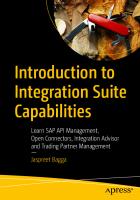A Practical Guide to SAP Integration Suite: SAP’s Cloud Middleware and Integration Solution 9781484293362, 9781484293379, 1484293363
This book covers the basics of SAP’s Integration Suite, including a broad overview of its capabilities, installation, an
153 104 19MB
English Pages 416 [407]
Table of contents :
Table of Contents
About the Author
About the Technical Reviewer
Acknowledgments
Introduction
Chapter 1: Introduction to Integration
1.1 What Is System Integration?
1.2 Examples of Integration in Real Life
1.3 Types of Integration
1.3.1 Process Integration
Three Types of Process Integration
1.3.2 Data Integration
Advantages of Data Integration
Disadvantages of Data Integration
1.3.3 Business-to-Business Integration
Components of B2B Integration
Advantages of B2B Integration
Challenges in B2B Integration
1.4 Patterns of Integration
1.4.1 Star Integration
Advantages of Star Integration
Disadvantages of Star Integration
1.4.2 Horizontal (ESB) Integration
1.4.3 Point-to-Point Integration
1.4.4 Hub and Spoke Integration
1.5 Advantages of Integration
1.5.1 Automation and Simplification
1.5.2 Availability, Correctness, and Coordination
1.5.3 Effectiveness and Productivity
1.5.4 Cost-Effectiveness
1.5.5 Scalability
1.5.6 Availability of Performance Insights
1.5.7 Security
1.6 Disadvantages of Integration
1.6.1 Security Issues
1.6.2 Issues in Upgrades or Maintenance Updates
1.6.3 High Cost
1.7 The Role of Integration in Enterprise
1.7.1 Sharing Important Information
1.7.2 Streamlining IT Procedures
1.7.3 Expanding Possibilities
1.7.4 Benefits of Enterprise Integration
1.7.5 Enterprise Integration Scenarios
1.8 Legacy System Integration
1.8.1 Key Challenges of Legacy System Integration
1.8.2 Legacy Integration Methods
1.8.3 Modern Methods of Integration
1.9 Integration Technologies (Middleware)
1.9.1 On-Premises Middleware
1.9.2 Hybrid Middleware
1.9.3 Cloud Middleware
1.10 Summary
Chapter 2: SAP Integration Suite
2.1 What Is SAP BTP?
2.2 Overview of the SAP Integration Suite
2.3 Capabilities of the SAP Integration Suite
2.3.1 Cloud Integration
2.3.2 API Management
2.3.3 Open Connectors
2.3.4 Integration Advisor
2.3.5 Trading Partner Management
2.3.6 Integration Assessment
2.3.7 Migration Assessment
2.4 Features of the SAP Integration Suite
2.5 Benefits of the SAP Integration Suite
2.6 SAP BTP Integration Suite Landscape
2.7 The SAP Integration Suite and Security
2.7.1 Transport and Message Level Security
2.7.2 Access SAP BTP Cockpit
Role Collection for Global Account
Role Collections for the Subaccount
2.7.3 Access SAP BTP Integration Suite
2.7.4 Creating Custom Roles
2.7.5 Create a Custom Role Collection
2.7.6 Assigning Role Collections to Users
2.7.7 Access Management for Cloud Integration
2.8 Trial Account Setup: The SAP Integration Suite
2.8.1 Setting Up the BTP Trial Account
2.8.2 Create a Space with Cloud Foundry
2.8.3 Managing Entitlements
Add Missing Entitlements
2.8.4 Subscribing to the Service
2.8.5 Assigning a Role Collection
2.8.6 Provisioning Capabilities
2.8.7 Booster: Automatically Build Service Instances and Assign Roles
2.9 Setting Up the Process Integration Runtime (Optional)
2.9.1 Creating a Service Key
2.10 Common Errors (Installation)
2.11 Recent Updates
2.12 Accessing the Integration Suite: Bookmark URLs
2.13 Summary
Chapter 3: SAP Cloud Integration: Features and Connectivity
3.1 What Is Cloud Integration?
3.1.1 Key Features of SAP Cloud Integration
3.1.2 Compatibility with Process Orchestration
3.1.3 Integration Capabilities
3.2 Overview of the SAP Cloud Integration Web UI
3.3 Sample Interface Development: Practical Example
3.3.1 Start Timer
3.3.2 Content Modifier
3.3.3 Outbound OData Channel
3.3.4 Groovy Script
3.3.5 Deploy and Monitor
3.4 Adapters—Sender and Receiver
3.4.1 Configuration of the JDBC Adapter: Practical Example
3.4.2 Connectivity Options and Communication Security
3.4.3 Connecting Inbound and Outbound Systems
3.4.4 Connecting a System to Cloud Integration
3.4.5 Supported Protocols
3.4.6 Inbound Communications
Setting Up an Inbound HTTP Connection
The Client Certificate Authentication for Integration Flow Process
OAuth with Client Credentials Grant for Integration Flow Processing
Basic Authentication Using Client ID and Client Secret
Basic Authentication of IdP User for Integration Flow Processing
Setting Up an Inbound SFTP Connection: Practical Example
Setting Up Inbound Mail Connections
3.4.7 Outbound Communications
Setting Up an Outbound HTTP Connection
Setting Up SAP Cloud Connector with a SAP Account
Setting Up HTTP Outbound Connections with a Client Certificate
Setting Up HTTP Outbound Connections with OAuth
Setting Up HTTP Outbound Connections with Basic Authentication
Setting Up an Outbound SFTP Connection in Cloud Integration
Setting Up an Outbound Mail Connection in SAP Cloud Integration
Creating X.509 Keys
Generate a Key Pair
Download a Certificate Signing Request
Request a Signed Certificate from a Certification Authority
Exchange the Key Material
Public Keys
Private Keys
Secure Communication
SFTP-Based Communication
3.5 Summary
Chapter 4: SAP Cloud Integration: Development Part I
4.1 Integration Content
4.1.1 Packaging Integration Content: Practical Example
Creating an Integration Package
Importing the Integration Package
Features of the Integration Package
Editing an Integration Package
Exporting an Integration Package
Predelivered Integration Packages (Interfaces)
Predelivered Integration Packages by SAP Partners (Abusiness)
SAP SuccessFactors Integration with JIRA
Configure Integration Flows
SAP S/4HANA Integration with ServiceNow API
4.1.2 Creating an Integration Flow Artifact
4.2 Iflow Design Object Elements
4.2.1 Participant
4.2.2 Process
Exception Subprocess (Error Handling): Practical Example
Integration Process
Local Integration Process
4.2.3 Events
End Message Event
Terminating Message Event
Start and End Message
Error Start and Error End Message
Timer Start
4.2.4 Message Transformations
Content Modifier
XML Modifier
Converter
JSON to XML Converter: Practical Example
Decoder
Encoder
EDI Extractor
Filter
Message Digest
Script
Create a Script Collection
Create Script in Script Collection
Consuming Script Collection
Deploying the Script Collection
Script Collection: Practical Example
4.2.5 Mapping
ID Mapping
Operation Mapping
XSLT Mapping
Message Mapping
Message Mapping Functions
Message Mapping Testing
Message Mapping: Practical Example
4.3 Summary
Chapter 5: SAP Cloud Integration: Development Part II
5.1 Iflow Design Object Elements
5.1.1 Call
External Calls
Request Reply
Content Enricher: Practical Example
Poll Enricher
Send
Local Call
Process Call
Looping Process Call
Idempotent Process Call
5.1.2 Routing
Aggregator
Gather and Join
Multicast
Splitter
Router: Practical Example
5.1.3 Security and Message-Level Security Use Case Configuration
Signer
PKCS7 Signer
Simple Signer
XML Digital Signature
Decryptor
PGP Decryptor
PKCS7 Decryptor
Encryptor
PGP Encryptor
PKCS7 Encryptor
PGP Encryption and Decryption: Practical Example
5.1.4 Persistence
Data Store Operations
Persist
Write Variables: Practical Example
5.1.5 Validator
EDI Validator
XML Validator
5.2 Version Management: Practical Example
5.2.1 Version Management: Restore/Revert
5.3 Externalized Parameters: Practical Example
5.3.1 Externalization Editor
5.3.2 Create a New Parameter
5.3.3 Reusing Existing Parameters
5.3.4 Removing Parameters
5.3.5 Managing Externalized Parameters
5.3.6 Configure Externalized Parameters
5.3.7 Error-Handling Strategies
5.4 Develop API-Based Integration Artifacts
5.4.1 SOAP, REST, and OData API Artifact: Practical Example
SOAP API Artifacts Example
REST API Artifact Example
OData API Artifact Example
5.4.2 OData API Project in SAP Cloud Integration: Practical Example
5.5 Process Direct Adapter: Practical Example
5.5.1 Configuring the Process Direct Sender Adapter
5.5.2 Configuring the Process Direct Receiver Adapter
5.5.3 Basic Configuration for the Process Direct Adapter
5.6 Configuring the SFTP Adapter: Practical Example
5.6.1 Configure the SFTP Receiver Adapter
5.7 Summary
Chapter 6: SAP Cloud Integration: Monitoring and Operations
6.1 Monitoring Message Processing
6.1.1 Message Logs
Using Groovy for Printing Logs: Practical Example
6.1.2 Message Processing Logs: View Content
6.1.3 Log Level Setup
6.2 Managing Integration Content
6.2.1 Integration Content Detail
6.2.2 Runtime Status
6.2.3 iflow Endpoint View
6.3 Managing Security
6.3.1 Create Security Material
Create User Security Material Artifact
OAuth2 Client Credentials Artifact
OAuth2 SAML Bearer Assertion
OAuth2 Authorization Code
Secure Parameter Artifact
Deploy SSH Known Host File
6.3.2 Manage Keystore Entries
Create Keystore Entries
Add Keystore Entries
Certificate
Key Pair
Keystore
Additional Keystore Operations
6.3.3 Manage PGP Keys
Deploy PGP Public Keyring
Deploy PGP Secret Keyring
6.3.4 Access Policy Management
Create an Access Policy
6.3.5 JDBC Material Management: Practical Example
Manage JDBC Data Sources
JDBC Driver Configuration
6.3.6 User Roles
6.3.7 Connectivity Test
TLS Connectivity
SSH Connectivity
FTP Connectivity
SMTP Connectivity
IMAP Connectivity
AMQP Connectivity
POP3 Connectivity
Kafka Connectivity
6.4 Managing Stores
6.4.1 Manage Data Stores
6.4.2 Manage Variables
6.4.3 Manage Message Queues
6.4.4 Manage Number Ranges
6.5 Using Access Logs
6.5.1 Access Logs in the Neo Environment
Monitor Audit Log
Monitor System Logs
6.5.2 Access Logs in the Cloud Foundry Environment
Monitor System Log Files
6.6 Managing Locks
6.6.1 Message Locks
6.6.2 Designtime Artifact Locks
6.7 Summary
Chapter 7: SAP Cloud Integration: Security
7.1 Security Cloud Foundry Environment
7.1.1 Certificate Management
7.1.2 Technical Landscape and Identity Access Management
7.1.3 Data Storage, Protection, Privacy, and Security in Cloud Foundry
7.1.4 Types of Stored Data in Cloud Foundry
7.1.5 Message Logs, Contents, Storage, and Retention in Cloud Foundry
7.1.6 Malware Scanner
7.1.7 UI Security
7.2 Security in the Neo Environment
7.2.1 Data Protection and Data Flow for Cloud Integration in Neo
7.2.2 Identity Access Management
7.2.3 Data Storage Security
7.2.4 Types of Stored Data
7.2.5 Specific Data Sets
7.2.6 UI Security
7.2.7 Remote API Security
7.3 Summary
Index
Table of Contents
About the Author
About the Technical Reviewer
Acknowledgments
Introduction
Chapter 1: Introduction to Integration
1.1 What Is System Integration?
1.2 Examples of Integration in Real Life
1.3 Types of Integration
1.3.1 Process Integration
Three Types of Process Integration
1.3.2 Data Integration
Advantages of Data Integration
Disadvantages of Data Integration
1.3.3 Business-to-Business Integration
Components of B2B Integration
Advantages of B2B Integration
Challenges in B2B Integration
1.4 Patterns of Integration
1.4.1 Star Integration
Advantages of Star Integration
Disadvantages of Star Integration
1.4.2 Horizontal (ESB) Integration
1.4.3 Point-to-Point Integration
1.4.4 Hub and Spoke Integration
1.5 Advantages of Integration
1.5.1 Automation and Simplification
1.5.2 Availability, Correctness, and Coordination
1.5.3 Effectiveness and Productivity
1.5.4 Cost-Effectiveness
1.5.5 Scalability
1.5.6 Availability of Performance Insights
1.5.7 Security
1.6 Disadvantages of Integration
1.6.1 Security Issues
1.6.2 Issues in Upgrades or Maintenance Updates
1.6.3 High Cost
1.7 The Role of Integration in Enterprise
1.7.1 Sharing Important Information
1.7.2 Streamlining IT Procedures
1.7.3 Expanding Possibilities
1.7.4 Benefits of Enterprise Integration
1.7.5 Enterprise Integration Scenarios
1.8 Legacy System Integration
1.8.1 Key Challenges of Legacy System Integration
1.8.2 Legacy Integration Methods
1.8.3 Modern Methods of Integration
1.9 Integration Technologies (Middleware)
1.9.1 On-Premises Middleware
1.9.2 Hybrid Middleware
1.9.3 Cloud Middleware
1.10 Summary
Chapter 2: SAP Integration Suite
2.1 What Is SAP BTP?
2.2 Overview of the SAP Integration Suite
2.3 Capabilities of the SAP Integration Suite
2.3.1 Cloud Integration
2.3.2 API Management
2.3.3 Open Connectors
2.3.4 Integration Advisor
2.3.5 Trading Partner Management
2.3.6 Integration Assessment
2.3.7 Migration Assessment
2.4 Features of the SAP Integration Suite
2.5 Benefits of the SAP Integration Suite
2.6 SAP BTP Integration Suite Landscape
2.7 The SAP Integration Suite and Security
2.7.1 Transport and Message Level Security
2.7.2 Access SAP BTP Cockpit
Role Collection for Global Account
Role Collections for the Subaccount
2.7.3 Access SAP BTP Integration Suite
2.7.4 Creating Custom Roles
2.7.5 Create a Custom Role Collection
2.7.6 Assigning Role Collections to Users
2.7.7 Access Management for Cloud Integration
2.8 Trial Account Setup: The SAP Integration Suite
2.8.1 Setting Up the BTP Trial Account
2.8.2 Create a Space with Cloud Foundry
2.8.3 Managing Entitlements
Add Missing Entitlements
2.8.4 Subscribing to the Service
2.8.5 Assigning a Role Collection
2.8.6 Provisioning Capabilities
2.8.7 Booster: Automatically Build Service Instances and Assign Roles
2.9 Setting Up the Process Integration Runtime (Optional)
2.9.1 Creating a Service Key
2.10 Common Errors (Installation)
2.11 Recent Updates
2.12 Accessing the Integration Suite: Bookmark URLs
2.13 Summary
Chapter 3: SAP Cloud Integration: Features and Connectivity
3.1 What Is Cloud Integration?
3.1.1 Key Features of SAP Cloud Integration
3.1.2 Compatibility with Process Orchestration
3.1.3 Integration Capabilities
3.2 Overview of the SAP Cloud Integration Web UI
3.3 Sample Interface Development: Practical Example
3.3.1 Start Timer
3.3.2 Content Modifier
3.3.3 Outbound OData Channel
3.3.4 Groovy Script
3.3.5 Deploy and Monitor
3.4 Adapters—Sender and Receiver
3.4.1 Configuration of the JDBC Adapter: Practical Example
3.4.2 Connectivity Options and Communication Security
3.4.3 Connecting Inbound and Outbound Systems
3.4.4 Connecting a System to Cloud Integration
3.4.5 Supported Protocols
3.4.6 Inbound Communications
Setting Up an Inbound HTTP Connection
The Client Certificate Authentication for Integration Flow Process
OAuth with Client Credentials Grant for Integration Flow Processing
Basic Authentication Using Client ID and Client Secret
Basic Authentication of IdP User for Integration Flow Processing
Setting Up an Inbound SFTP Connection: Practical Example
Setting Up Inbound Mail Connections
3.4.7 Outbound Communications
Setting Up an Outbound HTTP Connection
Setting Up SAP Cloud Connector with a SAP Account
Setting Up HTTP Outbound Connections with a Client Certificate
Setting Up HTTP Outbound Connections with OAuth
Setting Up HTTP Outbound Connections with Basic Authentication
Setting Up an Outbound SFTP Connection in Cloud Integration
Setting Up an Outbound Mail Connection in SAP Cloud Integration
Creating X.509 Keys
Generate a Key Pair
Download a Certificate Signing Request
Request a Signed Certificate from a Certification Authority
Exchange the Key Material
Public Keys
Private Keys
Secure Communication
SFTP-Based Communication
3.5 Summary
Chapter 4: SAP Cloud Integration: Development Part I
4.1 Integration Content
4.1.1 Packaging Integration Content: Practical Example
Creating an Integration Package
Importing the Integration Package
Features of the Integration Package
Editing an Integration Package
Exporting an Integration Package
Predelivered Integration Packages (Interfaces)
Predelivered Integration Packages by SAP Partners (Abusiness)
SAP SuccessFactors Integration with JIRA
Configure Integration Flows
SAP S/4HANA Integration with ServiceNow API
4.1.2 Creating an Integration Flow Artifact
4.2 Iflow Design Object Elements
4.2.1 Participant
4.2.2 Process
Exception Subprocess (Error Handling): Practical Example
Integration Process
Local Integration Process
4.2.3 Events
End Message Event
Terminating Message Event
Start and End Message
Error Start and Error End Message
Timer Start
4.2.4 Message Transformations
Content Modifier
XML Modifier
Converter
JSON to XML Converter: Practical Example
Decoder
Encoder
EDI Extractor
Filter
Message Digest
Script
Create a Script Collection
Create Script in Script Collection
Consuming Script Collection
Deploying the Script Collection
Script Collection: Practical Example
4.2.5 Mapping
ID Mapping
Operation Mapping
XSLT Mapping
Message Mapping
Message Mapping Functions
Message Mapping Testing
Message Mapping: Practical Example
4.3 Summary
Chapter 5: SAP Cloud Integration: Development Part II
5.1 Iflow Design Object Elements
5.1.1 Call
External Calls
Request Reply
Content Enricher: Practical Example
Poll Enricher
Send
Local Call
Process Call
Looping Process Call
Idempotent Process Call
5.1.2 Routing
Aggregator
Gather and Join
Multicast
Splitter
Router: Practical Example
5.1.3 Security and Message-Level Security Use Case Configuration
Signer
PKCS7 Signer
Simple Signer
XML Digital Signature
Decryptor
PGP Decryptor
PKCS7 Decryptor
Encryptor
PGP Encryptor
PKCS7 Encryptor
PGP Encryption and Decryption: Practical Example
5.1.4 Persistence
Data Store Operations
Persist
Write Variables: Practical Example
5.1.5 Validator
EDI Validator
XML Validator
5.2 Version Management: Practical Example
5.2.1 Version Management: Restore/Revert
5.3 Externalized Parameters: Practical Example
5.3.1 Externalization Editor
5.3.2 Create a New Parameter
5.3.3 Reusing Existing Parameters
5.3.4 Removing Parameters
5.3.5 Managing Externalized Parameters
5.3.6 Configure Externalized Parameters
5.3.7 Error-Handling Strategies
5.4 Develop API-Based Integration Artifacts
5.4.1 SOAP, REST, and OData API Artifact: Practical Example
SOAP API Artifacts Example
REST API Artifact Example
OData API Artifact Example
5.4.2 OData API Project in SAP Cloud Integration: Practical Example
5.5 Process Direct Adapter: Practical Example
5.5.1 Configuring the Process Direct Sender Adapter
5.5.2 Configuring the Process Direct Receiver Adapter
5.5.3 Basic Configuration for the Process Direct Adapter
5.6 Configuring the SFTP Adapter: Practical Example
5.6.1 Configure the SFTP Receiver Adapter
5.7 Summary
Chapter 6: SAP Cloud Integration: Monitoring and Operations
6.1 Monitoring Message Processing
6.1.1 Message Logs
Using Groovy for Printing Logs: Practical Example
6.1.2 Message Processing Logs: View Content
6.1.3 Log Level Setup
6.2 Managing Integration Content
6.2.1 Integration Content Detail
6.2.2 Runtime Status
6.2.3 iflow Endpoint View
6.3 Managing Security
6.3.1 Create Security Material
Create User Security Material Artifact
OAuth2 Client Credentials Artifact
OAuth2 SAML Bearer Assertion
OAuth2 Authorization Code
Secure Parameter Artifact
Deploy SSH Known Host File
6.3.2 Manage Keystore Entries
Create Keystore Entries
Add Keystore Entries
Certificate
Key Pair
Keystore
Additional Keystore Operations
6.3.3 Manage PGP Keys
Deploy PGP Public Keyring
Deploy PGP Secret Keyring
6.3.4 Access Policy Management
Create an Access Policy
6.3.5 JDBC Material Management: Practical Example
Manage JDBC Data Sources
JDBC Driver Configuration
6.3.6 User Roles
6.3.7 Connectivity Test
TLS Connectivity
SSH Connectivity
FTP Connectivity
SMTP Connectivity
IMAP Connectivity
AMQP Connectivity
POP3 Connectivity
Kafka Connectivity
6.4 Managing Stores
6.4.1 Manage Data Stores
6.4.2 Manage Variables
6.4.3 Manage Message Queues
6.4.4 Manage Number Ranges
6.5 Using Access Logs
6.5.1 Access Logs in the Neo Environment
Monitor Audit Log
Monitor System Logs
6.5.2 Access Logs in the Cloud Foundry Environment
Monitor System Log Files
6.6 Managing Locks
6.6.1 Message Locks
6.6.2 Designtime Artifact Locks
6.7 Summary
Chapter 7: SAP Cloud Integration: Security
7.1 Security Cloud Foundry Environment
7.1.1 Certificate Management
7.1.2 Technical Landscape and Identity Access Management
7.1.3 Data Storage, Protection, Privacy, and Security in Cloud Foundry
7.1.4 Types of Stored Data in Cloud Foundry
7.1.5 Message Logs, Contents, Storage, and Retention in Cloud Foundry
7.1.6 Malware Scanner
7.1.7 UI Security
7.2 Security in the Neo Environment
7.2.1 Data Protection and Data Flow for Cloud Integration in Neo
7.2.2 Identity Access Management
7.2.3 Data Storage Security
7.2.4 Types of Stored Data
7.2.5 Specific Data Sets
7.2.6 UI Security
7.2.7 Remote API Security
7.3 Summary
Index

- Author / Uploaded
- Jaspreet Bagga








![Practical Process Automation: Orchestration and Integration in Microservices and Cloud Native Architectures [1 ed.]
149206145X, 9781492061458](https://ebin.pub/img/200x200/practical-process-automation-orchestration-and-integration-in-microservices-and-cloud-native-architectures-1nbsped-149206145x-9781492061458.jpg)
